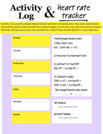
This is an interactive worksheet designed for highschool PE students to use to track their physical activity and target heart rate.
- Subject:
- Health, Medicine and Nursing
- Material Type:
- Activity/Lab
- Author:
- Gunnar Hansen
- Date Added:
- 03/03/2024

This is an interactive worksheet designed for highschool PE students to use to track their physical activity and target heart rate.
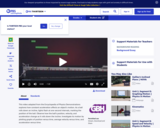
In this video adapted from the Encyclopedia of Physics Demonstrations, learn how plotting the changes in an object's position on a graph can provide information about the object's motion.

In this video lesson, the concept of momentum applied to hard-body collisions is explained using a number of simple demonstrations, all of which can be repeated in the classroom. Understanding Newton's Laws is fundamental to all of physics, and this lesson introduces the vital concepts of momentum and energy, and their conservation. Only some preliminary ideas of algebra are used here, and all the concepts presented can be found in any high-school level physics book. In terms of materials required, getting hold of large steel balls may not be easy, but large ball bearings can be procured easily. On the basis of what students have learned in the video, teachers can easily generate a large number of questions that relate to one's daily experiences, or which pose new challenges: for example, in a collision between a heavy and light vehicle, why do those inside the lighter one suffer less injury?
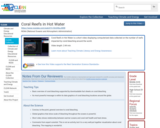
Coral Reefs in Hot Water is a short video displaying computerized data collected on the number of reefs impacted by coral bleaching around the world.

John's Experiment - Physical Science - Grades 6-8

Students investigate the property dependence between liquid and solid interfaces and determine observable differences in how liquids react to different solid surfaces. They compare copper pennies and plastic "coins" as the two test surfaces. Using an eye dropper to deliver various fluids onto the surfaces, students determine the volume and mass of a liquid that can sit on the surface. They use rulers, scales, equations of volume and area, and other methods of approximation and observation, to make their own graphical interpretations of trends. They apply what they learned to design two super-surfaces (from provided surface treatment materials) that arecapable of holding the most liquid by volume and by mass. Cost of materials is a parameter in their design decisions.
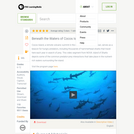
Cocos Island, a remote volcanic summit in the middle of the Pacific Ocean, serves as a beacon for hungry predators, including thousands of hammerhead sharks that travel here each year in search of prey. This video segment from NOVA: "Island of Sharks" depicts some of the common predator-prey interactions that take place in the nutrient-rich waters surrounding the island.

Mount St. Helen's - Physical Science - Grades 6-8
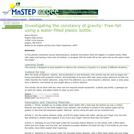
In this physics interactive lecture demonstration, students will investigate the effects of acceleration due to gravity in a number of different situations using a plastic water bottle. Based on an original activity from Peter Hopkinson, AAPT.
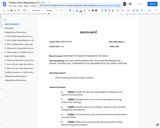
Hello Everyone,
This is my 5 day lesson plan for the CTE Training. I hope that it is useful for your classes in Health Sciences and in Family and Consumer Sciences.
Kristen Smith

This course offers a broad overview of physical, chemical, biological, geological, principles of environmental sciences, and serves as a core course for EEOS majors. Examples will focus on linked watershed and coastal marine systems. The student will be introduced to natural processes and interactions in the atmosphere, in the ocean, and on land. There is a focus on biogeochemical cycling of elements as well as changes of these natural cycles with time, especially with recent anthropogenic effects. Topics include plate tectonics, global climate change, ozone depletion, water pollution, oceanography, ecosystem health, and natural resources.
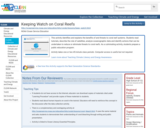
This activity identifies and explains the benefits of and threats to coral reef systems. Students read tutorials, describe the role of satellites, analyze oceanographic data and identify actions that can be undertaken to reduce or eliminate threats to coral reefs. As a culminating activity, students prepare a public education program.

This first course in the physics curriculum introduces classical mechanics. Historically, a set of core concepts—space, time, mass, force, momentum, torque, and angular momentum—were introduced in classical mechanics in order to solve the most famous physics problem, the motion of the planets.
The principles of mechanics successfully described many other phenomena encountered in the world. Conservation laws involving energy, momentum and angular momentum provided a second parallel approach to solving many of the same problems. In this course, we will investigate both approaches: Force and conservation laws.
Our goal is to develop a conceptual understanding of the core concepts, a familiarity with the experimental verification of our theoretical laws, and an ability to apply the theoretical framework to describe and predict the motions of bodies.

Students design systems that use microbes to break down a water pollutant (in this case, sugar). They explore how temperature affects the rate of pollutant decomposition.

In this interactive activity, learners explore factors that cause atoms to form (or break) bonds with each other. The first simulation depicts a box containing 12 identical atoms. Using a slider to add heat, students can see the influence of temperature on formation of diatomic bonds. Simulations #2 and #3 introduce learners to reactions involving two types of atoms. Which atom forms a diatomic molecule more easily, and why? The activity concludes as students explore paired atoms (molecules). In this simulation they compare the amount of energy needed to break the molecular bonds to the energy needed to form the bonds. This item is part of the Concord Consortium, a nonprofit research and development organization dedicated to transforming education through technology.

This lesson is the first one I use in my Line Dance Unit. It's a fun way to get kids moving and dancing. They're introduced to line dances and the elements of line dance.
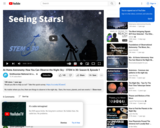
No matter where you live, there are things to observe in the night sky. In this episode learn how you can become a night sky observer.
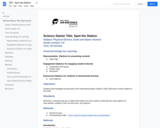
Students will investigate the geometry of the International Space Station's (ISS) orbit and its motion relative to the Earth.

To have a plan for students to learn about why we have a physical education class and the purpose of it

Heated Cup of Water - Physical Science - Grades 6-8